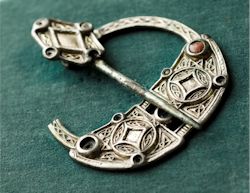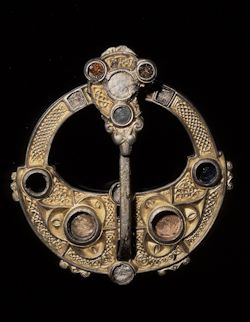

The desire to wear Insular dress ornaments is also reflected in the small number of ring brooches and ringed pins found in Trøndelag. Dress fasteners in the form of bronze ring-headed pins represent a widespread male fashion and were used to fasten an outer garment, e.g. a cloak. The commonest variety in Norway was the plain, ringed loop-headed pin, and it has its origins in Ireland in the pre-Viking period (Fanning 1994, 15-23). Ringed pins found in Norway are often regarded as Insular imports (e.g. Jåtten 2006; Geber 1991; Grønnesby and Ellingsen 2012). However, their simplicity complicates the problem of distinguishing imports into Scandinavia from their local copies (Graham-Campbell 1984, 35-38). Of the ringed pins from Trøndelag, three have rings with cubic knobs terminating in points and were regarded by Petersen (1940, 203-4) as probable Insular imports (Figure 7). The origins of four simple pins are more problematic. However, it can be noted that none of the simple types from Trøndelag display certain characteristics associated with Scandinavian copies, like the combination of large ring with a short pin or decoration in the form of rows of ring-and-dot stamping down its short pin (Graham-Campbell 2011, 103). The simple ringed pins from Trøndelag are therefore considered here as possible Insular imports, although this supposition must naturally be regarded with caution. In that connection, it can be noted that one of the simple ringed pins from the region was recovered together with an Insular balance scale from Lø, Steinkjer, perhaps suggesting a foreign origin for the pin as well.

Only 22 examples of imported Insular ring brooches have been identified in Norway, and four of these are found in Trøndelag (Glørstad 2010). One example comes from the coastal area at Nes, Bjugn, while the remaining brooches, from Snåsa, Fossem and Smolan, are concentrated in the inner part of the Trondheim fjord, within the old area of Inntrøndelag. The Norwegian term 'ring brooch' is used for convenience here, but recovered examples include both annular and penannular forms showing considerable variation. This group of artefacts is almost exclusively found in women's graves dated to the 9th century. In some cases, the Insular ring brooches have been found in situ on the middle of the chest or under the chin of the skeleton, between two oval brooches (Glørstad 2010, 210). The traditional dress of a wealthy Scandinavian woman during the Viking Age would have required the use of two substantial oval brooches to fasten the shoulder straps of a tunic worn over a shift, while a woman's third brooch - in the above cases Insular ring brooches – was used to fasten a cape or cloak. James Graham-Campbell (2001, 36) has suggested that the incorporation of Pictish and Irish brooch-types as cloak-fasteners in Norse dress might be viewed as 'glittering prizes' – the use of the exotic to make statements concerning status. Ann Zanette Glørstad (2010, 124) has, however, put forward an alternative explanation, suggesting that Insular ring brooches might have been brought to Norway at a time when the journeys to the British Isles had become more routine and where women themselves participated. Following this interpretation, the women buried with Insular ring brooches might have been Norse women communicating their personal connection with overseas colonies through their jewellery. Such items would display the economic and political resources that could be drawn from these Insular networks (Glørstad 2010, 38). In this connection, it is worth noting that two of the four known ring brooches from Trøndelag - found at Nes, Bjugn and Snåsa - represent the finest and best-preserved examples of this brooch-type found in the whole of Norway (Figure 8, Figure 9). The prestige of owning, and being buried with, such items may well indicate that the women, or at least their families, had a particularly important role within these overseas networks.

Internet Archaeology is an open access journal based in the Department of Archaeology, University of York. Except where otherwise noted, content from this work may be used under the terms of the Creative Commons Attribution 3.0 (CC BY) Unported licence, which permits unrestricted use, distribution, and reproduction in any medium, provided that attribution to the author(s), the title of the work, the Internet Archaeology journal and the relevant URL/DOI are given.
Terms and Conditions | Legal Statements | Privacy Policy | Cookies Policy | Citing Internet Archaeology
Internet Archaeology content is preserved for the long term with the Archaeology Data Service. Help sustain and support open access publication by donating to our Open Access Archaeology Fund.
File last updated: Wed Dec 3 2014